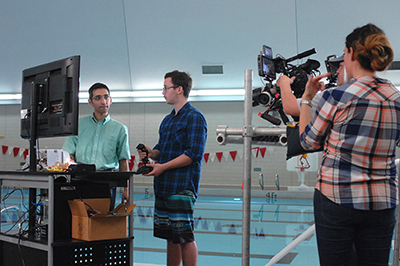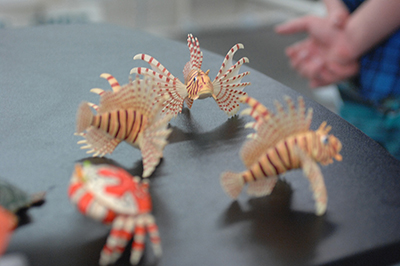Discovery Channel captures Lionfish project
A film crew from Discovery Channel Canada visited campus recently to capture the progress made by researchers in the Phillip M. Drayer Department of Electrical Engineering on an innovative lionfish-hunting robot.
 The segment will air on the channel through Daily Planet, an hour-long science and technology magazine that airs five nights per week nationally, with larger stories exported worldwide. Videos are also posted to social media sites.
The segment will air on the channel through Daily Planet, an hour-long science and technology magazine that airs five nights per week nationally, with larger stories exported worldwide. Videos are also posted to social media sites.
“Lamar’s team is working on this lionfish project—its purpose being a means of identifying Lionfish in the wild so that divers can go down and capture them or do whatever they need to do,” Discovery Channel project director Christine Mayall said. “It’s really interesting because on one hand you have the robotics, but you also have the computer science aspect to it—how they’ve been able to have this robot identify the lionfish, something that seems very complicated because of its intricate patterns.”
The popular aquarium species, native to the Pacific, has grown from an intentional or inadvertent release of as few as eight females off the Florida coast in the 1980s to a scourge along the eastern seaboard of the U.S., throughout the Caribbean and the Gulf of Mexico. Today, lionfish threaten to collapse entire reef ecosystems and cause incalculable losses for sport and commercial fisheries. Venomous, voracious, and seemingly unstoppable, the lionfish can be called the perfect storm among invasive species.
“This fish will eat practically whatever it can fit in its mouth,” Harley Myler, the William B. and Mary G. Mitchell Endowed Chair in Engineering and chair of the Phillip M. Drayer Department of Electrical Engineering in the College of Engineering, said. “It lacks natural enemies.”
 Myler’s team, including assistant professor Hassan Zargarzadeh, doctoral student Mahdi Naddaf and undergraduate students, have been working since January of last year on the remote-operated vehicle.
Myler’s team, including assistant professor Hassan Zargarzadeh, doctoral student Mahdi Naddaf and undergraduate students, have been working since January of last year on the remote-operated vehicle.
"Mahdi Naddaf has spent hundreds of days and nights on this project," Zargarzadeh said. "It was literally impossible without his dedicated work."
They are currently working to test and refine the technology on campus using models in the indoor pool. For now, they hope to improve the recognitive ability of the robots to single out lionfish. In the future, however, they are optimistic that the robots can be deployed in swarms in varied habitats of the Flower Garden Banks National Marine Sanctuary.
“The project is important because of how it affects the ecosystem of the U.S. Coastal waters in the Gulf and Atlantic,” Tristen Harris, electrical engineering major and student researcher said. “The lionfish are an invasive species and prevent the native fauna from flourishing. Current methods of removing the lionfish can be improved if the dive teams use a robot.”
Harris, who built the robot demonstrated in the pool, said he’s excited about Discovery Channel’s interest in the project.
“I am confident that in reaching such a large audience, it will help our project and our department by gaining us some good publicity,” he said. “But more importantly, I hope it will get people to recognize the problem posed by lionfish.”
Ultimately, Mayall said, it’s about using science and technology for good in the world—for bigger things.
“And this project fits.”
For more information about Daily Planet, visit the Facebook or Twitter pages @dailyplanet or visit Discovery Canada’s Daily Planet website for full episodes and other content.


